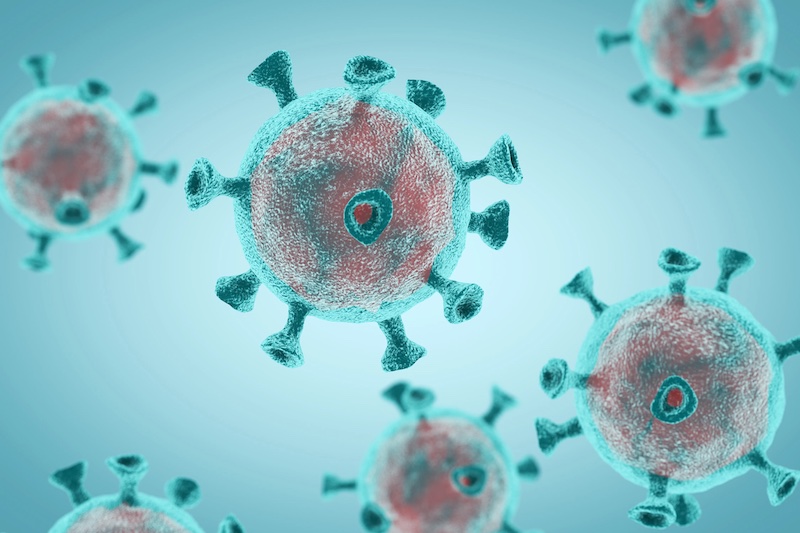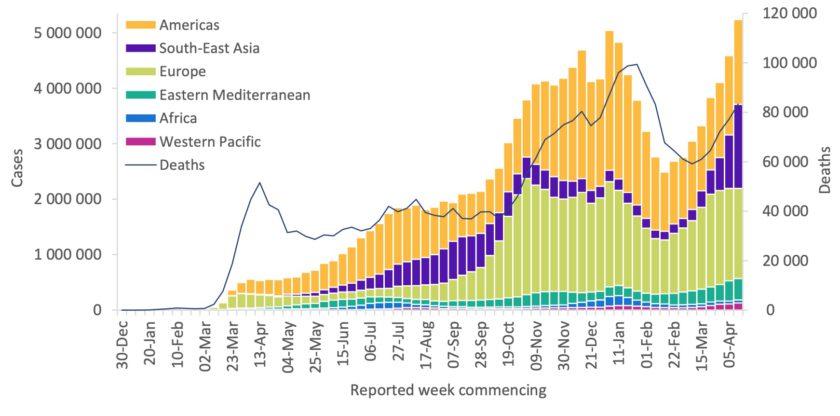
Each week the World Health Organization issues Epidemiological and Operational updates. We are in the middle of a global pandemic and so this is exactly what to expect.
The Weekly Epidemiological Update provides an overview of the global, regional and country-level COVID-19 cases and deaths, highlighting key data and trends; as well as other pertinent epidemiological information concerning the COVID-19 pandemic
The COVID-19 Weekly Operational Update reports on WHO and partners’ actions in response to the pandemic.
The one that is of immediate interest is the latest Epidemiological Update.
With vaccine rollout well under way and literally millions of shots already administered you are perhaps feeling that the end game is in sight.
Unfortunately no.
The latest Epidemiological Update – Dated April 20
Number of cases is surging globally – we are now in a new peak
Globally, new COVID-19 cases increased for the eighth consecutive week, with more than 5.2 million new cases reported in the last week – surpassing the previous peak in early January 2021.
Here is a graphical illustration of that.

Note also that the number of deaths is now also rapidly climbing.
The number of new deaths increased for the fifth consecutive week, an 8% increase as compared to the previous with over 83,000 new deaths reported.
Last week the reported cumulative COVID-19 death toll surpassed 3 million lives.
The pace of deaths is accelerating.
- It took nine months to reach 1 million deaths
- another four to surpass 2 million
- just three to reach 3 million deaths
What is going on?
While all regions except the European Region reported an increase in incident cases in the last week, the largest increase continues to be reported by the South-East Asia Region, largely driven by India, followed by the Western Pacific Region.
The countries reporting the highest number of new cases represent three of the six WHO regions:
- India (1,429,304 new cases; 64% increase)
- United States of America (477,778 new cases; 2% increase)
- Brazil (459,281 new cases; 1% decrease)
- Turkey (414,312 new cases; 17% increase)
- France (233,275 new cases; 12% decrease)
WHO Risk Assessment
Rather obviously the global public health risk remains very high.
The COVID-19 pandemic shows no signs of easing, with global case and death incidence increasing at a concerning rate since mid-February 2021.
A third of the global cumulative COVID-19 cases and deaths has been reported in the last three months alone, with weekly cases reaching similar levels as the previous peak in January 2021.
Marked geographical variation in the pandemic trajectory continues to be observed at regional and country levels, with sharp rises observed in the South-East Asia, Eastern Mediterranean and Western Pacific regions in recent weeks.
The global infection fatality ratio (IFR) was estimated between 0.1% to 1.0%, an increase from January largely driven by an increase in the Region of the Americas.
Globally mortality rates continue to be higher for those over 40 years as well as for males as compared to females.
Why has this surge happened?
Basically two reasons …
- The emergence of SARS-CoV-2 VOCs (variants of concern)
- All three VOCs are associated with increased transmission.
- Additionally, some have been associated with increased disease severity, increased risk of immune escape, and/or significant reductions in neutralization.
- Inconsistent use/early easing of public health and social measures
In addition to the three VOCs (variants of concern), six other variants have thus far been designated as SARS-CoV-2 variants of interest (VOIs), and a further 19 variants are currently under investigation, highlighting that especially as global incidence remains high, there is continued risk of emergence of more variants with phenotypic implications and global importance in the coming months.
Pandemic fatigue
While reports confirm that most people continue to support PHSM (public health and social measures) as part of national COVID-19 response strategies, pandemic fatigue is occurring, undermining the impact of PHSM on transmission.
Vaccine Distribution
A total of 781 million doses of COVID-19 vaccines have been administered in 196 economies. However, 24 economies (including 12 from the African Region and seven from the Western Pacific Region) have not yet started vaccination.
The current uneven and inequitable access and distribution of COVID-19 vaccines is exacerbating global inequalities, which coupled with the emergence of VOCs (variants of concern), risks prolonging the pandemic.
A great deal is still unknown
Much still remains unknown including …
- the effectiveness of vaccination in reducing transmission
- the duration of immunity
- the role of children in transmission
- the frequency and nature of post-COVID-19 condition (“long COVID”).
The emergence of VOCs introduces further unknowns such as the potential for immune escape and as to how these changes in the virus affect the global epidemiology.
Further Reading
You can access the latest WHO reports here.
